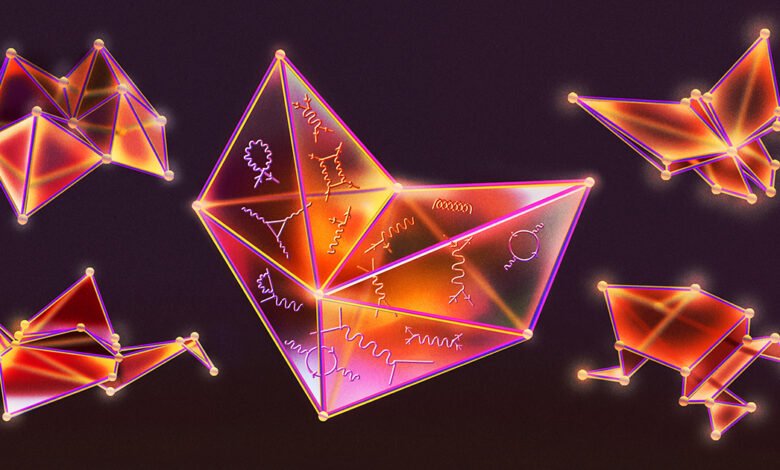Origami Unlocks a Major Physics Mystery

▼ Summary
– The amplituhedron is a geometric shape whose volume calculation provides answers to key particle interaction probabilities in physics.
– Mathematician Pavel Galashin discovered a connection between the amplituhedron and origami, showing that origami crease patterns translate into points forming the amplituhedron.
– Galashin used this origami link to prove the triangulation conjecture, confirming the amplituhedron can be subdivided into simpler geometric pieces that correspond to particle collision calculations.
– The amplituhedron was introduced in 2013 as a geometric representation of scattering amplitudes, offering a simpler alternative to complex methods like Feynman diagrams and BCFW recursion.
– This discovery bridges disparate fields and enables mathematicians to explore new insights into the amplituhedron and broader mathematical questions.
Discovering the hidden geometry of particle interactions has long challenged physicists, but a surprising connection to the ancient art of origami is now illuminating one of the field’s most profound mysteries. A mathematician at Cornell University, Pavel Galashin, recently demonstrated that intricate paper folding patterns correspond directly to a geometric shape known as the amplituhedron, an object whose volume encodes the probabilities of particle collisions. This unexpected link not only bridges two distant disciplines but also resolves a longstanding conjecture about how this shape can be subdivided into simpler components, confirming a key assumption in theoretical physics.
Galashin’s breakthrough builds on earlier work by physicist Nima Arkani-Hamed and his former student Jaroslav Trnka, who first introduced the amplituhedron in 2013. Arkani-Hamed described Galashin’s recent contribution as “next-level stuff,” emphasizing its significance for both mathematics and physics. By translating origami crease patterns into precise geometric points, Galashin showed that the amplituhedron emerges naturally from the principles of paper folding, revealing a deep unity between artistic craft and subatomic behavior.
The central challenge in particle physics involves predicting outcomes when particles like gluons collide. Each possible result, whether particles rebound, transform, or generate new ones, has a specific probability expressed through a mathematical quantity called a scattering amplitude. For decades, physicists relied on two main methods to compute these amplitudes. The first used Feynman diagrams, visual representations of particle interactions where each diagram corresponds to a mathematical term. However, as collision complexity increases, the number of required diagrams explodes, making calculations unwieldy.
A second approach, known as Britto-Cachazo-Feng-Witten (BCFW) recursion, simplifies the problem by breaking complex interactions into manageable parts. Using graphs to track these components, physicists reassemble them to determine overall amplitudes. While more efficient than Feynman diagrams, BCFW still involves extensive computations where many terms cancel out, obscuring the underlying simplicity of the final result.
Arkani-Hamed and Trnka’s discovery revealed that these cumbersome calculations were actually geometric in nature. They connected BCFW recursion to the positive Grassmannian, a mathematical space studied since the 1930s. This abstract construct consists of all planes within a higher-dimensional space that satisfy specific positivity conditions. To navigate its complex structure, mathematician Alexander Postnikov developed “plabic graphs”, networks of colored vertices and edges that map distinct regions of the Grassmannian.
When Arkani-Hamed and Trnka recognized their BCFW graphs mirrored Postnikov’s plabic graphs, they realized scattering amplitudes could be interpreted as volumes of a projected shadow of the Grassmannian. This insight gave birth to the amplituhedron, a geometric object whose volume directly yields scattering amplitudes without redundant computations.
A major unanswered question, however, was whether the amplituhedron could be neatly subdivided, or “triangulated”, into smaller pieces corresponding to individual BCFW terms. Proving this “triangulation conjecture” was essential to validating the amplituhedron as a fundamental description of particle interactions. While mathematicians confirmed it for one version of the shape in 2021, the more physically relevant “momentum amplituhedron” remained unresolved, until origami provided the key.
Galashin’s path to this discovery began indirectly. While investigating the Ising model, a framework for studying magnetic systems, he encountered research linking the positive Grassmannian to origami crease patterns. Intrigued by the mathematical richness of paper folding, he explored a conjecture about whether boundary data from a crease pattern could always be completed into a valid, flattenable origami shape. This problem resonated with his expertise in Grassmannian boundaries, leading him to uncover a precise correspondence between origami structures and the amplituhedron.
By formalizing this relationship, Galashin proved the triangulation conjecture for the momentum amplituhedron, ensuring its pieces fit together perfectly. His work not only solidifies the amplituhedron’s role in physics but also opens new avenues for exploring geometric structures through origami. Researchers are now leveraging this connection to tackle broader mathematical questions, demonstrating how insights from paper folding continue to reshape our understanding of the universe’s fundamental laws.
(Source: Quantam Magazine)